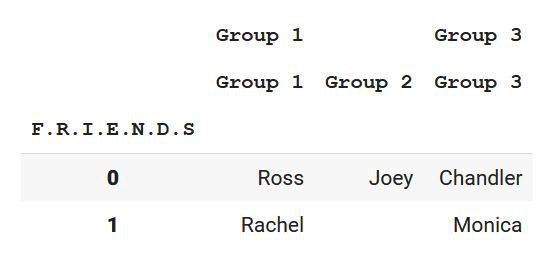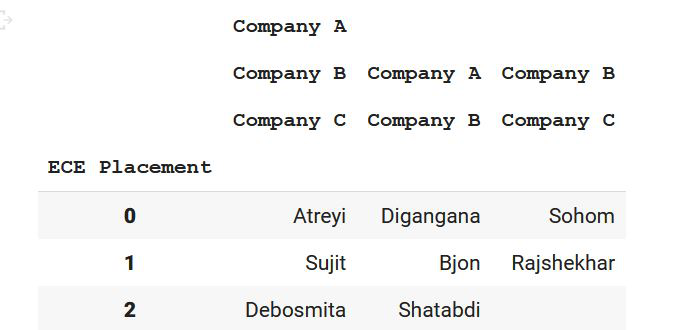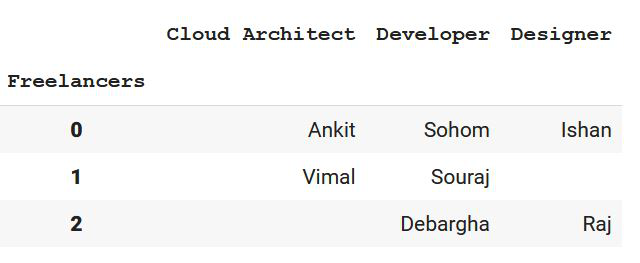How to drop a level from a multi-level column index in Pandas Dataframe ?
Last Updated :
21 Apr, 2021
In this article, we will learn about how to drop a level from a multi-level column index. But before that, we need to know what is a multi-level index. A multi-level index dataframe is a type of dataframe that contains multiple level or hierarchical indexing.
In this article, we will be creating a dataframe of our own choice with multiple column indexing, and then we are going to drop off a level of our hierarchical indexing.
Step by Step Implementation
Let's understand this using step-by-step implementation with the help of an example.
Step 1: Import all the libraries required.
Python3
# importing all important libraries
import pandas as pd
Step 2: Create a multi-level column index Pandas Dataframe and show it.
We are creating a multi-index column using MultiIndex.from_tuples() which helps us to create multiple indexes one below another, and it is created column-wise. After that, using pd.Dataframe() we are creating data and converting it into the tabular format with the column names as the multi-level indexes. Also, we are changing the index name of the table using df.index.
Python3
# Creating a multilevel index
index = pd.MultiIndex.from_tuples([("Group 1", "Group 1"),
("Group 1", "Group 2"),
("Group 3","Group 3")])
# Creating a pandas dataframe with
# multilevel-column indexing
df = pd.DataFrame([["Ross","Joey","Chandler"],
["Rachel","","Monica"]],
columns=index)
# Labelling the dataframe index.
index = df. index
index. name = "F.R.I.E.N.D.S"
# Showing the above multi-index column
# dataframe
print(df)
Output:

Step 3: Drop the level(s) of the dataframe
Now a multi-level column index dataframe is created using python. Now let us implement the above concept now. We need to drop a level. We can do that using df.columns.droplevel(level=0). This helps us to drop an index level from the top that is of index 0.
Python3
# Dropping a level down
df.columns = df.columns.droplevel(0)
Step 4: Show the required result
Python3
Output:

Hence, we have been able to drop a level of index column successfully.
Let's see some more examples based on the above approach.
Example 1:
In the next example, we will be dropping a level from a specific index in the multi-level column index. This can be done using the same syntax we have used earlier[df.columns.droplevel(level=0)] where if we specify the level number, then the following index gets deleted according to zero-based indexing. So let us move to the implementation of the concept.
Python3
# importing all important libraries
import pandas as pd
# Creating a multilevel index
index = pd.MultiIndex.from_tuples([("Company A", "Company B","Company C"),
("Company A", "Company A","Company B"),
("Company A","Company B","Company C")])
# Creating a pandas dataframe with
# multilevel-column indexing
df = pd.DataFrame([["Atreyi","Digangana","Sohom"],
["Sujit","Bjon","Rajshekhar"],
["Debosmita","Shatabdi",""]],
columns=index)
# Labelling the dataframe index.
index = df. index
index. name = "ECE Placement"
# Showing the above multi-index column
# dataframe
print(df)
Output:

Now, if we want to drop level with index 2, then let's see what happens!
Python3
# Dropping a level number 2
df.columns = df.columns.droplevel(2)
print(df)
Output:

Hence, we can observe that in the multi-level column index, we have successfully removed the level with index number 2.
Example 2:
In this example, we will be implementing more concepts of the multi-level index. We will be deleting multiple levels at the same time.
Python3
# importing all important libraries
import pandas as pd
# Creating a multilevel index
index = pd.MultiIndex.from_tuples([("Company A", "Company B", "Company C"),
("Company A", "Company A", "Company B"),
("Company A", "Company B", "Company C")])
# Creating a pandas dataframe with
# multilevel-column indexing
df = pd.DataFrame([["Atreyi", "Digangana", "Sohom"],
["Sujit", "Bjon", "Rajshekhar"],
["Debosmita", "Shatabdi", ""]],
columns=index)
# Labelling the dataframe index.
index = df. index
index. name = "ECE Placement"
# Showing the above multi-index column
# dataframe
print(df)
Output:

As we can see, every list of arrays contains the indexes column-wise. So, three arrays mean three columns and the number of values in the array refers to the number of rows. Let us delete multiple indexes from the dataframe now. We can do that using df.columns.droplevel(level=0) by calling it multiple times. But here is a catch!
Python3
# Dropping a level down
df.columns = df.columns.droplevel(0)
# Dropping another level down
df.columns = df.columns.droplevel(0)
# Showing the dataframe
print(df)
As we can see, there are two droplevel statements with the level as 0. This is because, after the removal of a single level, the remaining ones get rearranged. So the level that was at index 1 will now come to index 0, Hence multiple droplevels are written in that case.
Output:

Hence, level 0 and level 1 get removed, and we are left with only level 2 which is now shown as level 0.
Example 3:
In the last example, let us remove multiple levels from various positions in the dataframe.
Python3
# importing all important libraries
import pandas as pd
# Creating a pandas dataframe
df = pd.DataFrame([["Coding", "System Design"],
["DBMS", "Aptitude"],
["Logical Reasoning", "Development"]])
# Creating multilevel index from tuples
df.columns = pd.MultiIndex.from_tuples([('Group 1', 'Group 2', 'Group 3', 'Group 4'),
('Group 3', 'Group 4', 'Group 5', 'Group 6')],
names=['level 1', 'level 2', 'level 3', 'level 4'])
# Showing the dataframe
print(df)
Output:

Now let us remove level 1 and 3 respectively:
Python3
# Dropping a level down(Level 1)
df.columns = df.columns.droplevel(0)
# Dropping a level down after
# re-arrangement(Level 2)
df.columns = df.columns.droplevel(1)
# Showing the dataframe
print(df)
As we can see, we have dropped a level down from index 0 in the first case. After re-arrangement level 2 will now come to the 0 indexes of the multi-level index dataframe. Now in order to remove level 3 now, we have to specify the level as 1 according to the 0-based indexing after re-arrangement. Now levels 2 and 4 will be shown in the resultant output.
Output:

Similar Reads
How to drop one or multiple columns in Pandas DataFrame Let's learn how to drop one or more columns in Pandas DataFrame for data manipulation. Drop Columns Using df.drop() MethodLet's consider an example of the dataset (data) with three columns 'A', 'B', and 'C'. Now, to drop a single column, use the drop() method with the column’s name.Pythonimport pand
4 min read
How to drop rows in Pandas DataFrame by index labels? Dropping rows in a Pandas DataFrame by index labels is a common operation when you need to remove specific rows based on their index positions. For example, we are working with a DataFrame that contains details of students, including their names, ages, and universities. Initially, the DataFrame has
5 min read
How to Delete a column from Pandas DataFrame Deleting data is one of the primary operations when it comes to data analysis. Very often we see that a particular column in the DataFrame is not at all useful for us and having it may lead to problems so we have to delete that column. For example, if we want to analyze the students' BMI of a partic
2 min read
How to flatten a hierarchical index in Pandas DataFrame columns? In this article, we are going to see the flatten a hierarchical index in Pandas DataFrame columns. Hierarchical Index usually occurs as a result of groupby() aggregation functions. Flatten hierarchical index in Pandas, the aggregated function used will appear in the hierarchical index of the resulti
6 min read
Drop Columns in DataFrame by Label Names or by Index Positions This article will discuss dropping columns in Pandas DataFrame by label names or index positions. Dropping columns can be achieved using methods like drop(), iloc[], loc[], and iterative approaches. Let’s explore these methods with examples.Drop Columns by Label Names or Index Positions Using drop()
3 min read
How to convert index in a column of the Pandas dataframe? Each row in a dataframe (i.e level=0) has an index value i.e value from 0 to n-1 index location and there are many ways to convert these index values into a column in a pandas dataframe. First, let's create a Pandas dataframe. Here, we will create a Pandas dataframe regarding student's marks in a pa
4 min read